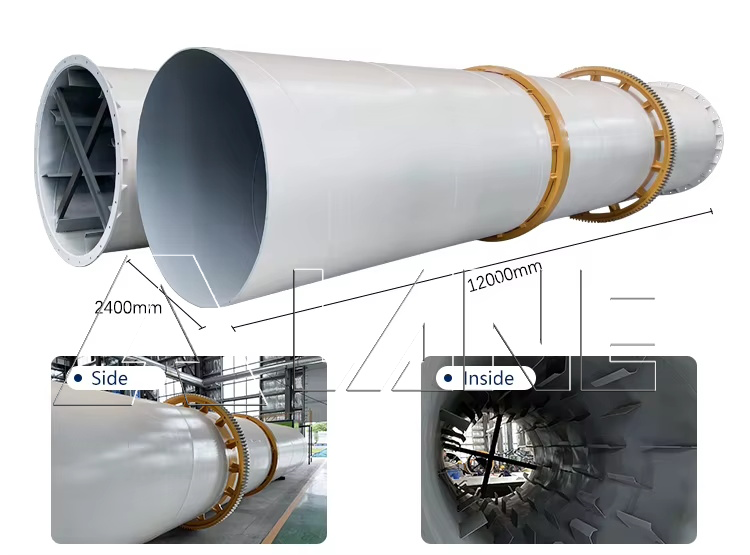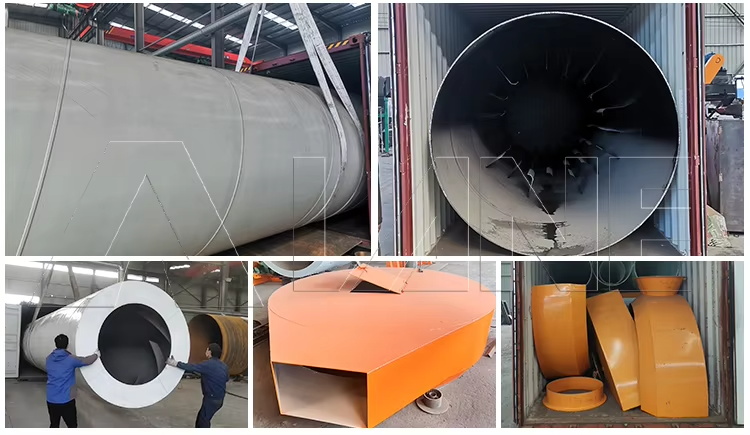Rotary drum dryers are essential equipment in fertilizer production and are ideal for drying fertilizers. They are commonly used to dry organic, compound, and inorganic fertilizers, reducing the moisture content of fertilizer granules or powders from 70%–80% to 13% or less.

Why use dry fertilizers?
Drying is a key step in fertilizer production, directly affecting yield, quality, and energy consumption.
Rotary drum dryers are used to dry organic, compound, and inorganic fertilizers
Preventing caking: Wet fertilizer granules have a high moisture content and are prone to breaking and caking. Dry fertilizers have a lower moisture content and are more storable and less likely to clump or deteriorate.
Extending shelf life: Dry fertilizers are more stable and maintain their effectiveness longer.
Increasing efficiency: Dry fertilizers are easier to distribute evenly, which increases their efficiency.
Reducing weight: Drying reduces moisture content, weight, and volume, which reduces transportation costs.
Secondary granulation: The dryer can not only dry, but also perform secondary granulation, improve the solubility of organic fertilizer, increase the granulation rate, ensure uniform particles, and increase production.
Rotary drum dryers are commonly used to dry organic fertilizers, compound fertilizers, and inorganic fertilizers (nitrogen fertilizers, phosphate fertilizers, and potassium fertilizers).
Rotary drum dryer: key equipment for fertilizer drying
The rotary drum dryer is a key equipment for fertilizer drying. Its working principle is to tilt the rotating drum so that the fertilizer inside is constantly rolling, and the hot air enters from one end of the drum, fully contacts the fertilizer, and quickly evaporates the moisture. The dried fertilizer is discharged from the other end.
LANE Machinery’s fertilizer dryer has been upgraded many times and now uses the latest drying technology to quickly and evenly dry various types of fertilizers and improve product quality.

1. Uniform drying
The rotary drum dryer precisely controls the heating to ensure that each grain of fertilizer is evenly exposed to the hot air, thereby achieving consistent moisture removal and high-quality output.
2. Energy efficiency
The dryer uses thermal energy effectively, and most of the heat is used to evaporate moisture. The advanced heat recovery system and thermal insulation function help minimize energy consumption, and the thermal efficiency reaches 80%–90%.
3. High throughput
The dryer can process up to 76 tons of fertilizer per hour, meeting the needs of continuous and batch production processes and meeting strict production requirements.
4. Fast drying speed
The dryer has excellent heat and mass transfer performance, large temperature gradient, fast water evaporation, and a drying speed of 30~70kg/(m²·h).
5. Strong insulation
The drum adopts composite silicon insulation coating, silicon fiber board, mineral wool board, and is reinforced with wire mesh. This design reduces heat loss, maintains a high internal temperature, and accelerates the drying process.
6. Wide range of fuel uses
The rotary drum dryer can use a variety of fuels, such as coal, natural gas, biogas, biomass pellets, etc. Users can choose according to resource conditions to reduce operating costs.
4 key factors in the fertilizer drying process
1. Residence time in the rotary dryer
Organic fertilizers usually need to stay in the rotary drum dryer for more than 22 minutes. The longer the drum, the longer the material is heated, which improves the utilization rate of thermal energy.
2. Temperature in the dryer
In order to protect beneficial microorganisms, the drying temperature should be kept below 60°C. The temperature of the hot air in contact with the material should not exceed 130°C.
For example, when using urea, the head temperature of the dryer should be kept below 160℃ and the tail temperature below 70℃ to avoid problems such as melting or softening.
3. Airflow in the dryer
The size of the air volume directly affects the drying effect. It is generally calculated according to the cross-sectional area of the dryer cylinder. 7000m3/h is appropriate. The wind speed should be less than 2m/s. A regulating valve should be installed on the pipe before or after the fan to adjust the air volume.
For example, install a valve at the air inlet of the blower. If the furnace temperature is too low, increase the air volume; if the furnace temperature is too high, reduce the air volume.
4. Heat exchange in the dryer
Organic fertilizer will melt and stick to the wall at high temperature, increase the equipment load, weaken the lift effect of the plate in the rotary dryer, reduce the heat exchange efficiency, make it difficult to dry the material into particles, and make the equipment more difficult to clean.
To solve this problem, reduce the density of the lifting plate and minimize dead zones or external influences.

Problem 1: Too many large particles or lumps
If the dryer discharge contains more than 15% large particles (>4.75 mm) or lumps, it may be due to the following reasons:
1. Too much moisture in the particles or too high initial moisture, you need to reduce the moisture in the granulation or use dehydration equipment
2. The dryer temperature is low, you need to increase the temperature and check the combustion system
3. The screening is uneven, you need to add or adjust the screening equipment
4. If the rotation speed is incorrect, it needs to be adjusted to the optimal speed
Problem 2: Too much fine powder
If the content of fine powder (>1mm) discharged from the dryer exceeds 15%, it may be due to the following reasons:
1. Insufficient liquid phase during granulation, it is necessary to increase the steam and moisture in the granulator
2. The compost viscosity is low, so it is necessary to adjust the formula and increase the viscosity additive
3. The drying temperature or time is too long, so it is necessary to lower the temperature or shorten the drying time
4. The return material and the fresh material are not mixed evenly, so it is necessary to improve the mixing equipment or extend the mixing time
5. The equipment is worn or aged, so it is necessary to regularly inspect and maintain the equipment and replace the worn parts
For more details, please feel free to contact us.
Henan Lane Heavy Industry Machinery Technology Co., Ltd.
Email: sales2@lanesvc.com
Contact number: +86 15515885328
Whatsapp: +86 15515885328